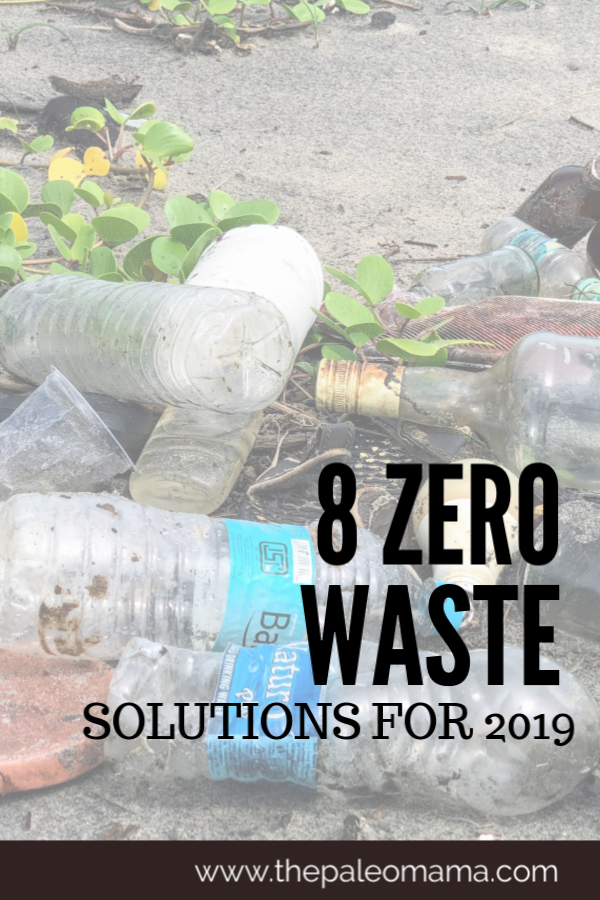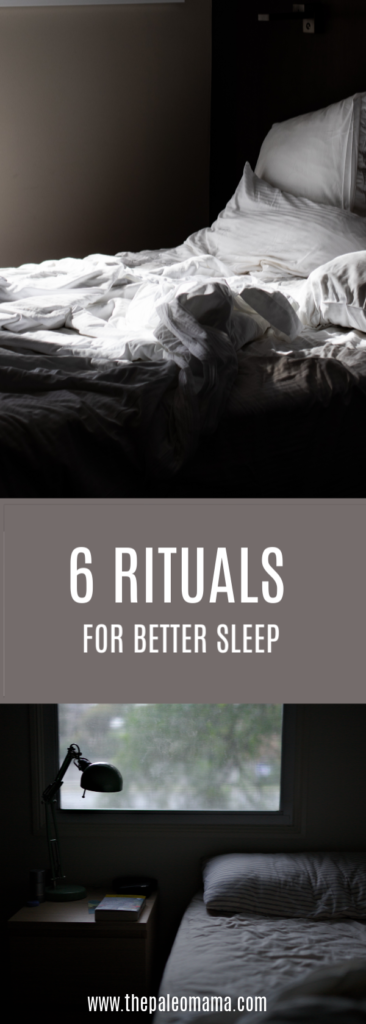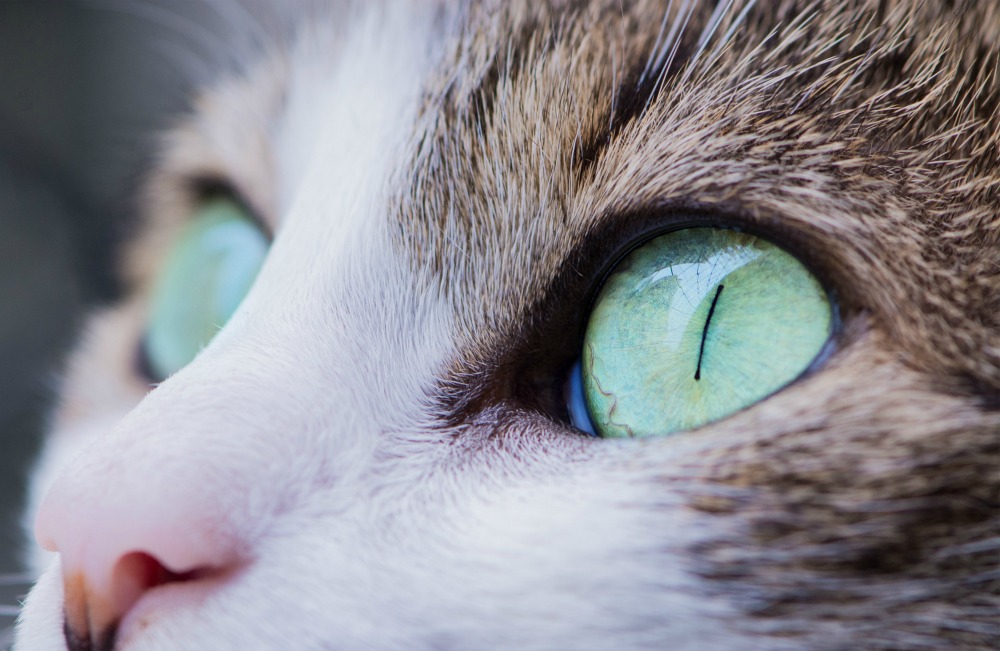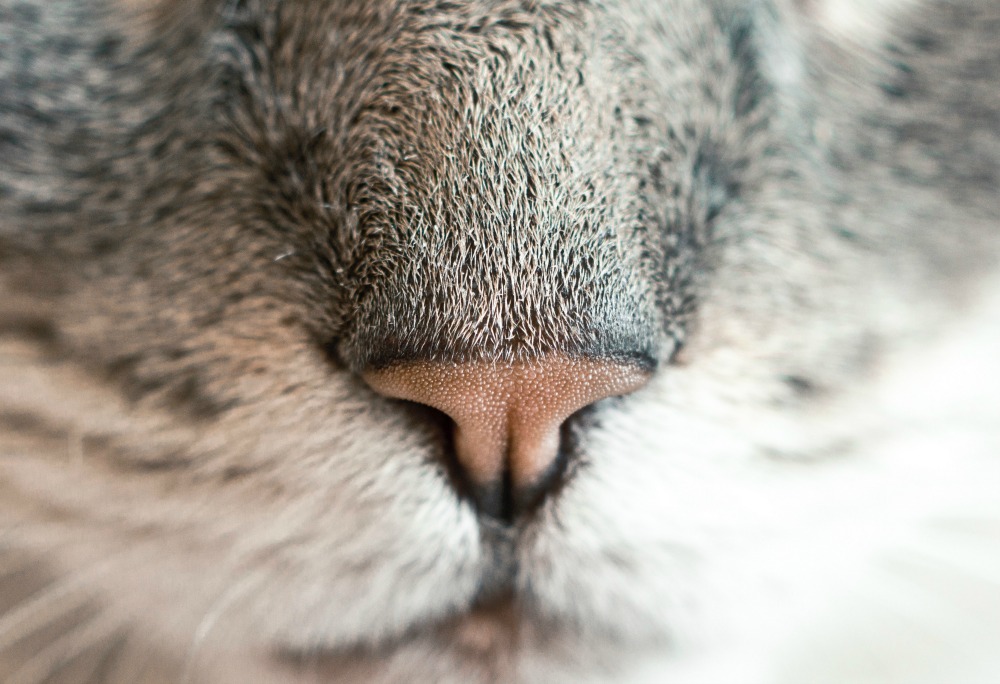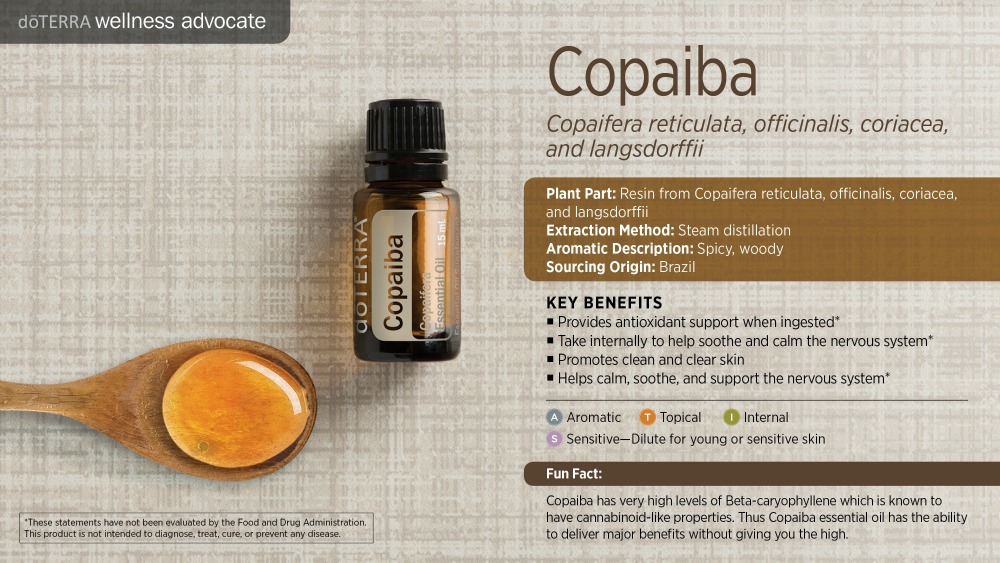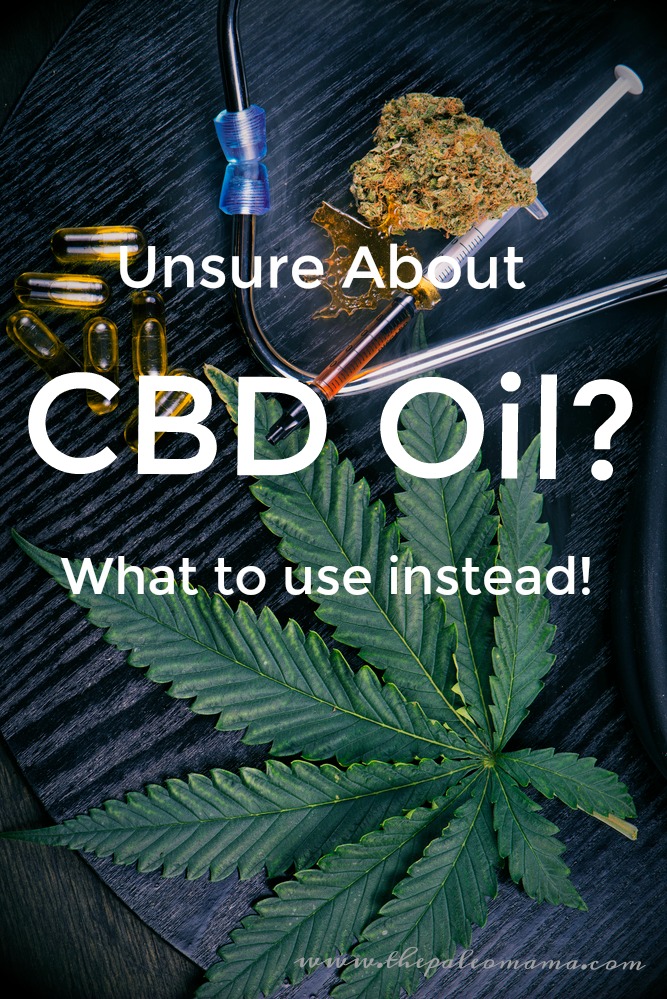Over on Instagram and Facebook I started a series on my daily rituals and tools that I use to stay on task. For those of you who don’t know me that well, let me introduce myself to you so that you can see why I am a huge advocate of rituals and habits.
My life mission has always been to help other people gain access to the tools they need to live a healthy, natural, toxic-free life. This passion is what led me to start The Paleo Mama blog which helps millions of people each month through this website and social media.
As I was starting to change over my family’s life to a more unconventional way of living, I struggled with trying to maintain my sanity and find balance in it all. I had to dig and find the answers for what products were safe and, eventually, it all started to become a way of life for me.
It’s not always this easy for everyone. We don’t know how to begin this journey of living more natural so we try to change our whole way of living at once and what happens? We get so overwhelmed that we end up throwing in the towel and quitting.
Because I had this struggle in my own life, I know many of you have the same struggles. That is why I went on to write my first book, “Everyday Natural: Living a Pure and Simple Life Isn’t As Complicated As You Think.” I wanted to give my readers some simple swaps that they can make as they are moving towards natural living.
My mission of helping others gain tools led me to an essential oil company that had a similar mission I believed in. I created tools for families to make some healthy swaps around their homes using essential oils and over 10,000 families on my essential oil wellness team have made brought plant based medicine into their home. Hundreds of these families wanted to create an income doing something that they love and have joined forces with me and we collaborate, create, and teach essential oil wellness to thousands of people each month.
Because of my insatiable hunger for plant based medicine, I went onto learn more about herbs and essential oils and went to Herbalism school so that I could really learn more about these plants which were so many were finding healing in.
If you take a look around my website, you will see that everything I do and share is so that others can find the freedom, that I and thousands others, have found with natural living.
In fact, I have a huge love for getting my hands dirty with natural ingredients like coconut oil, shea butter, baking soda, almond oil, and essential oils. I love creating recipes that others can use to bring homemade beauty into their home. This is why I just released my brand new book, “The Home Apothecary: Home Crafted Recipes Using Herbs & Essential Oils“.
All this to say, I have a lot on my plate but I live a happy, joyful life that is free from toxic ingredients and toxic people. I’ve learned to say no to things that don’t bring me joy, health, and happiness.
I have several streams of income that I managed and I manage them pretty darn well.
How do I do it all? With rituals. Habits. Routines.
You guys — this has always been a struggle for me. I am a super, go-lucky, nothing bothers me, hate routines, and wants to change things up all the time. I had to dig deep and find some discipline (there was a little bit down there) to keep with these habits and rituals. These are what carry me and make me be my best self.
These habits create and spark ideas so I want to share them with you for the next 14 days.
Use this page and come back daily to find the updated resources, links and tools that you need to create your own daily rituals for success.
Jackie’s Daily Rituals
More explanations about each of these rituals and how I use these products is on my Instagram page.
Day 1: Healthy Teeth Rituals
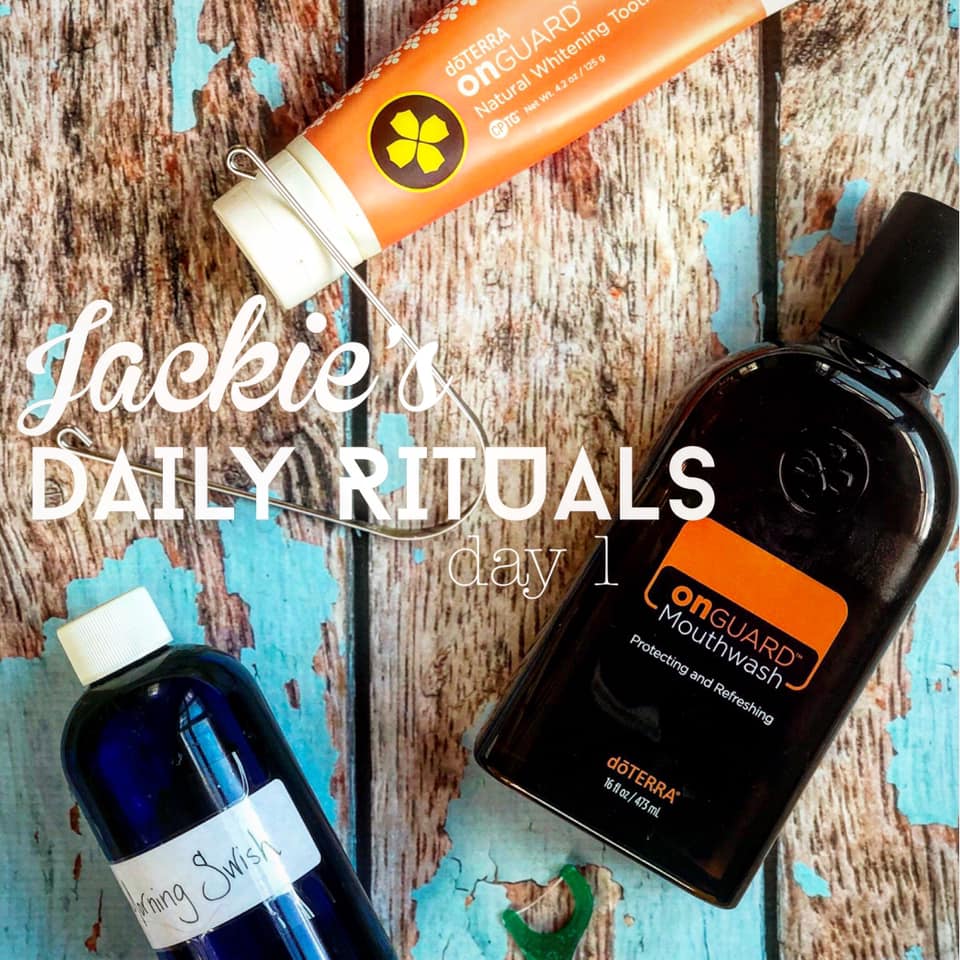
- Tongue Scraper
- OnGuard Toothpaste
- OnGuard Mouthwash
- Morning Swish recipe is in The Home Apothecary. You can go here to learn more about Oil Pulling.
For the next 14 days I am sharing some of the routines I do every, single day to keep me on my a-game as a mom, wife, entrepreneur, and natural woman.
.
So make sure you come over here to my page often, and check out the related blog post (link in profile) where I’m linking up all the tools for you! .
So let’s get started with day 1.
.
I wake up without an alarm clock between 5-5:30am. I’ve found that I MUST have 1.5-2 hours in quiet reflection and alone time to be a good human for that day. .
Upon immediately waking I:
✔️ Scrape my tongue
✔️ Brush my teeth –
✔️ Floss-
✔️ Rinse with OnGuard natural mouthwash-
✔️ Do my Morning Swish (oil pull) for 10-15 min while I do my next morning ritual.
.
So let’s break each of these down and explain what a few of them are. .
Tongue scraping is a Vedic practice that removes bacteria, food, toxins, fungi and dead cells from the surface of the tongue. Brushing your tongue will loosen the funk, but it doesn’t actually remove it. So I do a 10-count tongue scrape and you wouldn’t believe the stuff that comes off!
.
Don’t skip flossing! Just do it while you are making your morning coffee or filling up your diffusers (oops that’s part of another ritual I’ll be sharing this week).
And for those who don’t know what oil pulling is, it’s where you swish coconut oil around in your mouth for 5-15 min. This, also is a Vedic practice that helps to remove toxins and nourishes your teeth and gums. I put essential oils in mine! You can read all about which oils are great by clicking the link in my profile.
It’s easy to wake up, roll out of bed and skip doing these healthy oral rituals, but I have found that our oral health is a reflection of how we feel physiologically and psychologically. It really sets you up to show up as your best self.
Day 2: Morning Dry Brushing Ritual
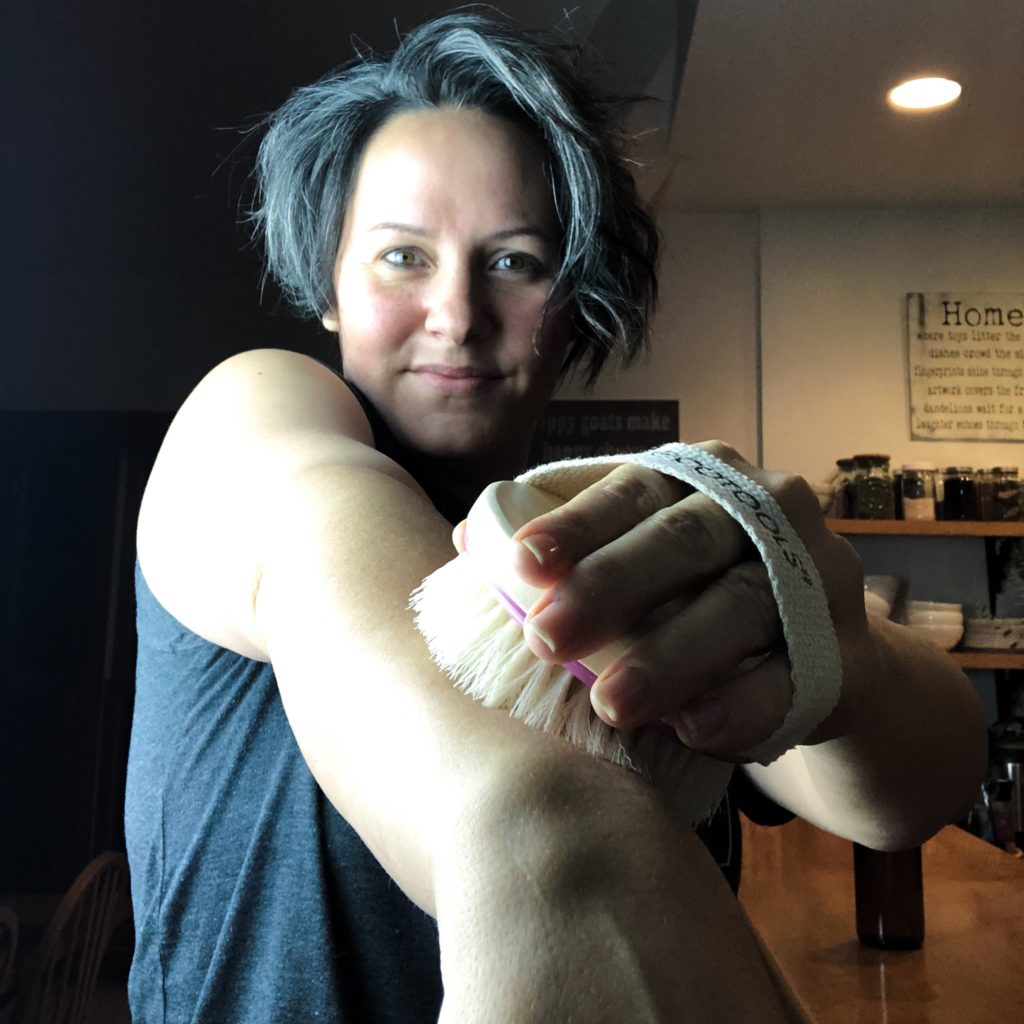
- My favorite dry brush
- Slim & Sassy essential oil blend
- Empty spray container – these are the best spray bottles I have ever used! I use them for our kitchen cleaner and bathroom spray cleaners too.
You brush your teeth, maybe your tongue, and your hair. Why not brush your skin!
Let’s talk about my day 2 ritual…I dry brush my skin right after waking and before showing.
BENEFITS OF DRY BRUSHING:
✔️ Exfoliation
✔️ Stimulate lymph flow & drainage
✔️ Brush off pores of dirt & oil-
✔️ Reduce cellulite (possibly)
✔️ Energize my body first thing in the morning
.
HOW TO DRY BRUSH:
✔️ First I spray my whole body down with a spray bottle with a homemade mix of Slim & Sassy Essential Oil and some water. This metabolic blend is energizing and stimulating (great for using first thing in the morning).-
✔️ Start at feet and brush the tops and bottoms. I usually brush each part of my body about 8-12 times (moving pretty quickly)
✔️ For lymph flow, always brush towards your heart; the center of your body.
✔️ Move up the legs and thighs.
✔️ Brush your palms and up your arms.
✔️ Brush your armpits and down the top of your chest (avoiding your breasts…ouch!).
✔️ Brush your stomach, moving clockwise to support digestion.
.
Once you try this practice, I’m confident you’re going to love it as much as I do! The dry brush is very soothing and feels divine!
Day 3: Fill up My Body and Diffusers with Water
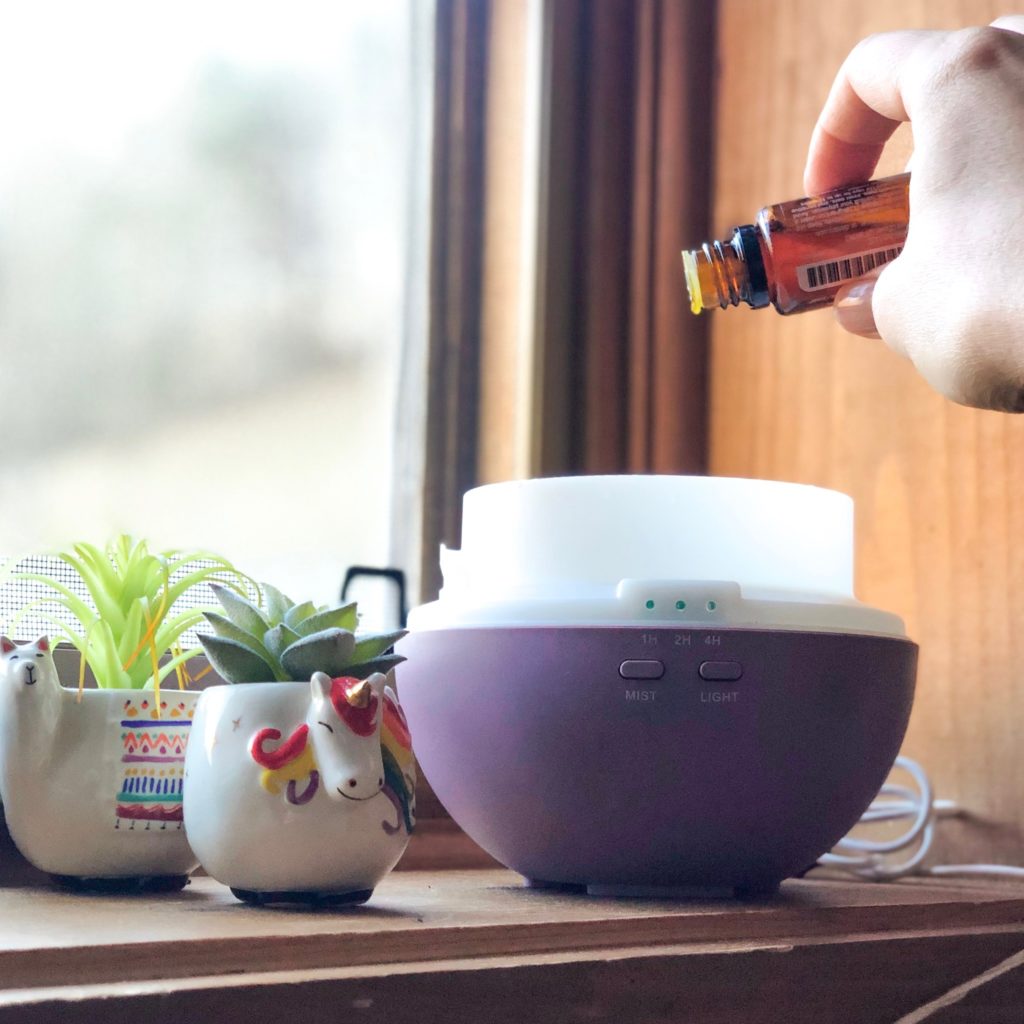
- Favorite diffuser for small space
- Favorite diffuser for large space
- Essential oil shelf
- Favorite water bottle
- Favorite essential oils
I used to wake up, roll out of bed, and plop down on the couch. I’d lay there while I caught up on social media, read the news, and consumed consumed consumed.
I was introduced to this concept of “create before consume” a year ago and it helped to completely change my mindset on how I want my mindset to be for the day.
I don’t want people influencing me, my joy, my outlook, or my day. So, I started this ritual of “create before consume” and have to tell you, it’s transformed my life, my business, and my marriage.
Instead of picking up my computer or phone first thing in the morning, I pick up my Bible, my journal or whatever book I am reading.
And one of things that has become a prompt for this behavior is the action of filling up my body with water and my diffusers with water. I’m very dehydrated (as we all are) when I wake up so I immediately drink a good 10-15oz of water, take my probiotic, and then move on to filling up the house diffusers.
Favorite Essential Oils to Diffuse:
- On Guard “immune boosting blend”
- Citrus Bliss “invigorating blend”
- Eucalyptus
- Serenity at bedtime
- Douglas Fir and Lime
- Peppermint and Tangerine
I may not turn all the diffusers on, but I do fill them up so that I can turn them on throughout the day when I need them. My diffuser that I use at bedtime, is filled up at this time so that when I’m tired and just want to go to bed, it’s ready to go and all I have to do is turn it on.
Diffusing essential oils is one of the best rituals you can get into. Aromatherapy is extremely beneficial for many things: improving your health, concentration, and mood.
I firmly believe in having readily available prompts throughout your house that encourage you to be consistent in these rituals. So I have an essential oil shelf near each diffusers that holds a few oils for me to choose from. This way, I’m not running all over the house looking for the essential oil I want to diffuse.
I have these prompts and reminders all over the house with each of my rituals. These reminders are set out at exactly where I need them so that I they remind me and I can grab and use them.
My water bottle is waiting for me on the kitchen counter and is already filled up with water. There are some essential oils I love putting in my water and those are right next to the sink as a reminder. My dry brush is out on display on my bathroom sink.
You don’t water just one plant at a time do you? Think of your diffusers as a plant that needs watering so that it can effectively work to improve the air in your home.
Day 4: Healthy Morning Coffee
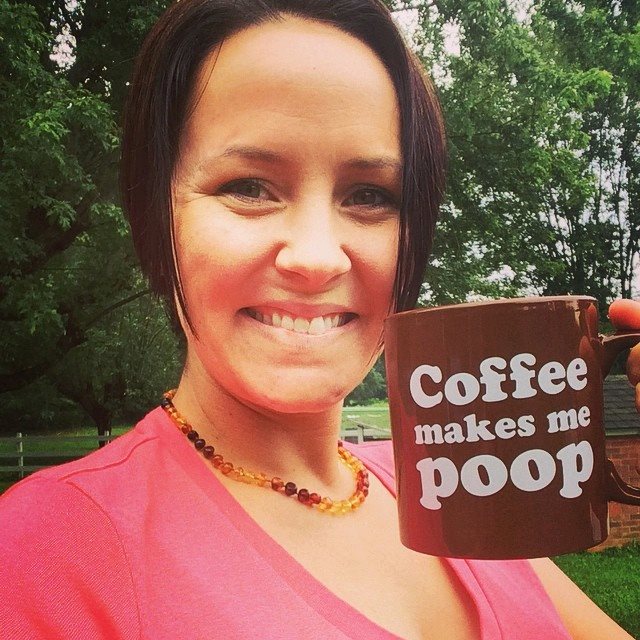
- How to Make a Bulletproof Coffee
- MCT Oil
- Butter-Flavored Coconut Oil (I use this because I’m 100% dairy-free right now. If you aren’t, just use healthy butter)
- Favorite Protein Powder to Add
- Collagen Peptides
- Favorite Coffee (I use decaf
After I dry brush, after I fill up my diffusers (and myself) with water, and after I take care of my mouth, I head over to the kitchen and make my morning brew.
But y’all…it ain’t just a regular coffee. My brew is loaded with protein and healthy fats to get me going, to improve my creating and thought processes, and to satiate my hunger for several of the morning hours.
Here’s how to make a delicious morning brew that is:
✔️healthy
✔️loaded with healthy fats
✔️has protein in it which is essential in the morning
✔️supports intermittent fasting
✔️quick and easy to make
✔️excellent for those who hate eating before they work out
HOW TO MAKE IT:
✔️brew a cup of high quality coffee (I use decaf)
✔️add to a blender: 1TB of coconut oil (I love butter flavored…remember I’m 100% dairy free right now) or 1 TB of MCT oil, 1 scoop of collagen peptides OR 1 scoop of Bone Broth Vanilla Protein powder
✔️ 1 ts of cinnamon or 1 drop of cinnamon oil
✔️if you use the bone broth protein powder you won’t need any sweetener. It’s sweetened with stevia and monk fruit. If you used the peptides, then you might need a sweetener of choice.
✔️Blend till frothy and enjoy while you move into #jackiesdailyrituals #5 (which I’ll post tomorrow)!
If you aren’t dairy free you can add a small bit of ghee or butter as well!
Day 5: Jackie’s MORNING Quiet Time Routine
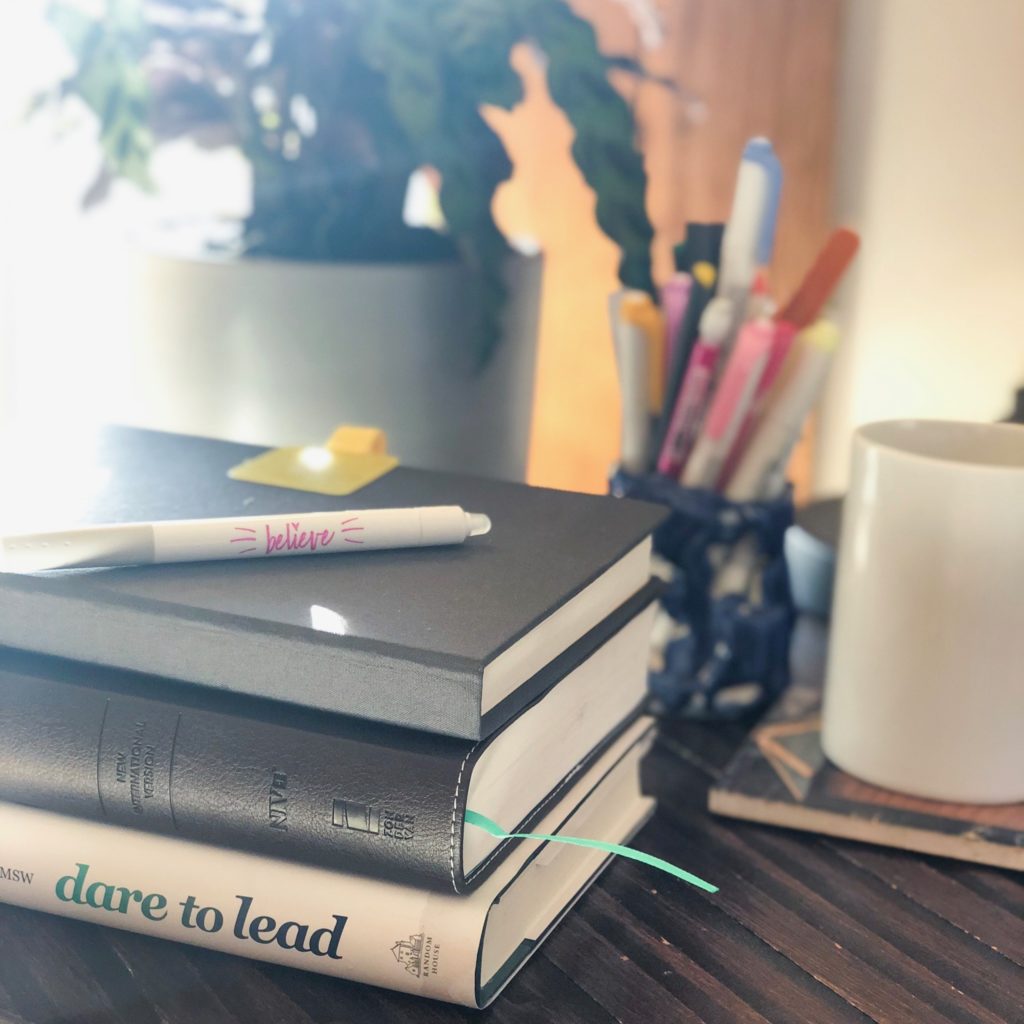
- List of my favorite books
- My favorite coloring Bible
- My favorite highlighters
- My favorite pens (they’re erasable!)
- This year I’m using the Best Self Journal
- I use a Bullet Journal for note-taking, doodling, and jotting down quotes from whatever book I’m reading, church or conferences
- I use this meal planner
I used to wake up to the noise of the kids and immediately got out of bed to start serving my family. I skipped everything I mentioned in the previous rituals, and got right to my mommy duties.
I never realized how this small habit made me grumpy and agitated all throughout the day.
A few years ago I started going to bed a little earlier so that I could attempt to wake up before my kids. Currently, I wake up almost 2 hours before them so that I can take care of me.
By the time they get up, mommy is filled up spiritually, physically, and emotionally. I am ready to see my kids and serve them.
This MUST be done in the morning before you start your day.
My Quiet Time Routine
- Do all the previous rituals of #jackiesdailyrituals
- Put on some quiet music
- Empty your bladder so it doesn’t disturb you
- Settle in a comfortable place with your morning coffee or tea
- Remember “create before consume.” So, don’t look at your social media, emails, or TV
- Grab your planner (if their is a space) or journal and write down 3 things you are grateful for
- Next, I read my Bible. I’m currently doing the year-plan with the Bible Project.
- Next I meditate and pray for a few minutes.
- Then I grab whatever book I’m reading (here’s a list of books I’ve read and loved) and spend 10-15 minutes reading a chapter or two.
- Now it’s time to plan my day. I grab my journal and write down anything I need to get done. I highlight appointments and phone calls so I remember to do them and set my phone alarm to remind me of them.
- I make a list of any notes, ideas or tasks that I need to get done.
- Then I identify and highlight my top 3 targets that will make today a win for me. I highlight them if they are on my larger list.
- I plan what we are having dinner.
- I put everything away, clean up my space, and start making breakfast for everyone! I feel amazing 🙂
Day 6: Sunday Batch Cooking and Meal Prep
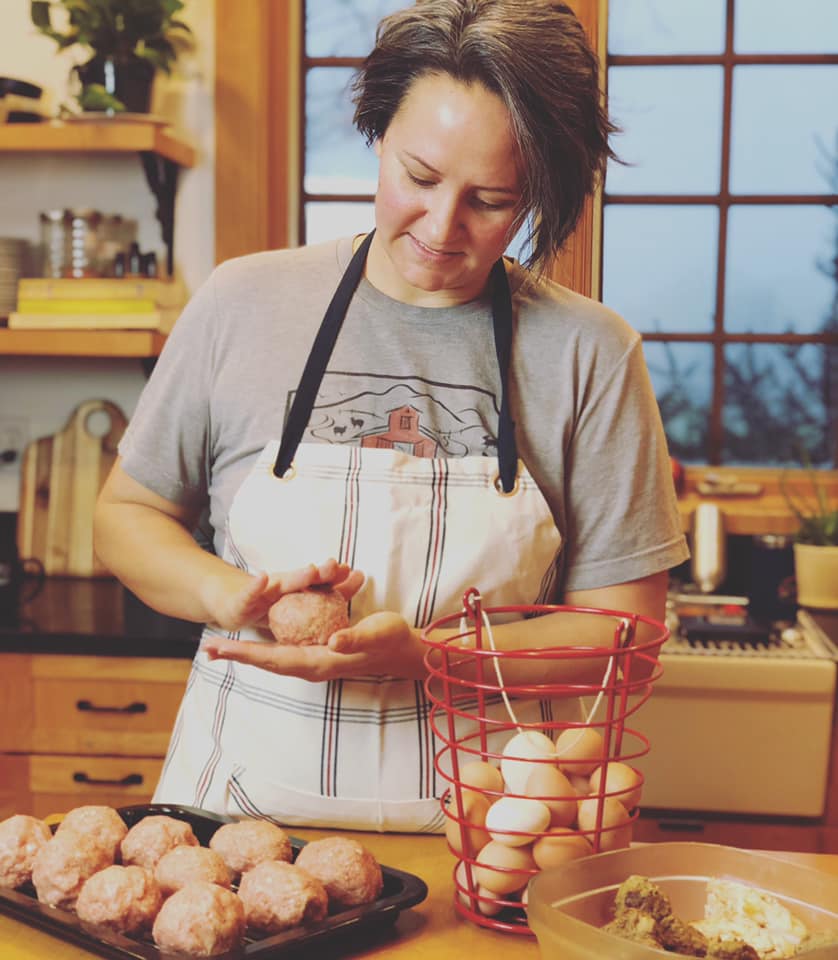
When I started meal planning and batch cooking on Sundays, my life became easier. When you have 4 people who eat 3 meals a day at home, it can become a little cray cray…especially if there isn’t a plan.
Sunday is the day I go through our freezer, fridge and pantry and plan dinners for the week. Since Frank and I work from home and live in a rural town with no delivery options for lunch, we make a large dinner and save the leftovers for lunches during the week.
The last thing I want to do, when I get working and in my creative space, is make lunch. So it’s nice to just have something to warm up.
I, also, batch cook a bunch of meat on Sunday: Scotch Eggs, meatballs, smoked fish (to throw on salads), etc. Pretty sure Scotch Eggs are the kids favorite breakfast! Throw a smoothie or banana with it and done! We make about 10-12 Scotch Eggs once a week.
HOW TO MAKE SCOTCH EGGS
✔️Boil 10 eggs (I actually boil about 20 eggs but only use 10 for this recipe.
✔️Peel them
✔️Take 2lbs of ground sausage and divide it into 10 balls
✔️Flatten the ball of sausage and wrap the sausage around the boiled eggs, making sure there aren’t any cracks
✔️Toss in the oven at 400 degrees for about 15 minutes
Meal planning and batch cooking will make your life a whole lot easier! I love and use Real Plans because it has only real, whole food recipes. Happy planning!
Day 7: Movement and Exercise (5x/week)
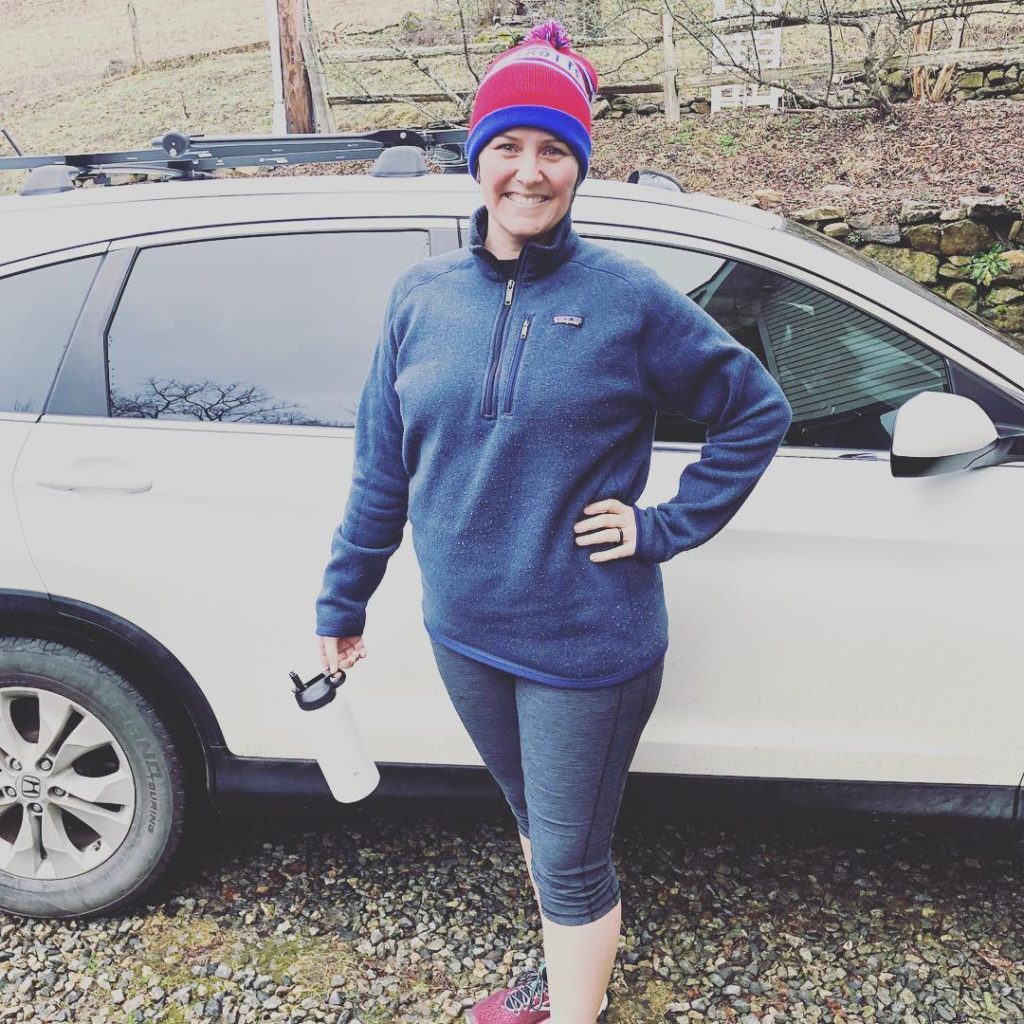
It is so easy to talk yourself out of things — especially exercise. Trust me, I did it for years. I can remember all the things that my mind used to tell myself….all the excuses:
- “Jackie, you live too far from a gym.”
- Jackie, you get enough exercise just holding down a farm.”
- “Jackie, it’s too cold outside.”
- “People drive crazy on your road. You can’t run on that.”
- “You can start a new workout routine tomorrow.”
- “Oh well, they don’t have child care.”
- “I’m too tired and didn’t sleep well.”
- “I just don’t have the time. I’m a full time parent who works from home.”
I could keep going. These excuses dominated my life and my mindset and it wasn’t until I fully committed to myself that I saw a change in my life.
So, I stopped saying these excuses and just started going to the gym. Yes, it’s a 15 minute drive. Yes, I hate going some days. Yes, it’s freezing outside. But I feel so much better!
Instead of listening to music during my workout, I listen to a podcast. I get a good 30-45 minutes of self-care + personal development done in that time and I have come to really enjoy it.
So, ladies, stop making all the excuses and just get your butt to a gym or go outside and take a walk. Put a motivating podcast in your ears and move your body.
Don’t do it as a way to punish your body or to “lose weight”. Do it because your body needs some movement to function optimally!
Day 8: Natural Skin Care Routine
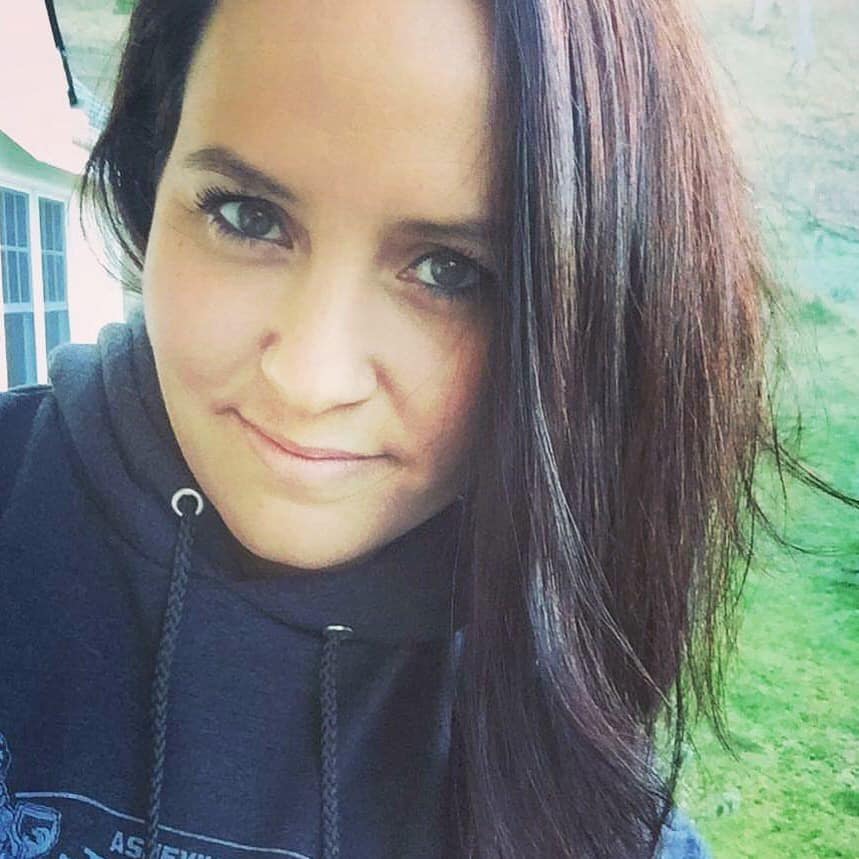
Products, Recipes, & Resources I use:
- Verage Plant-Based Skin Care Collection
- Yarrow POM Essential oil
- Derma Roller
- Bentonite Clay
- Think Dirty App
- Dry Brushing
- Homemade Facial Scrub
I’m excited to share with you today what my skincare routine looks like. It’s probably one of the top 10 questions I get from my readers. So I’m gonna wrap it all up and put it here in one juicy post!
DAILY ROUTINE:
✔️workout and sweat! It opens pores and releases toxins. I don’t wash my face before this.
✔️ Oil cleansing method: so I wash my face with almond oil\castor oil mix. Google it! I lather the oil all over my face and use a HOT washcloth to remove it. I do this at night too to remove makeup.
✔️ Quick Spray with Verage plant based toner.
✔️ Squirt of Verage serum in my palms + a few drops of whatever essential oil is calling me (usually it’s yarrow, Frankincense or neroli).
✔️ Drink tons of water. I drink nearly a gallon a day.
EVERY OTHER DAY to ONCE A WEEK:
✔️ Derma roll to reduce my rosacea and to boost collagen production
✔️ Exfoliate with a homemade scrub
✔️ Clay mask to suck out impurities and toxins.
That’s it! I’ve learned simple is so much better with your skin.
Day 9: Layer on the Oils
Putting on my essential oils, is just as important as putting on my clothes. And I don’t just put oils on me, I apply them on my children as well.
I created a morning ritual of applying my oils that I use for:
- emotional support
- physical support
- perfume
I apply them in that order (I don’t know why exactly other than I figured to tap into the deepest part of my body first).
For emotional support, I apply Balance essential oil to my chest and neck area. If it’s a “work-day” I like to layer Passion essential oil on top of that as it helps to inspire creative thoughts and focused work.
For physical support, I usually apply Frankincense and, sometimes, Deep Blue. I, quickly, add a drop to my palms and rub it on the bottom of each foot. Then I grab my bottle of Fennel or DigestZen and I rub some of it over my belly area. I do this daily, regardless of how I feel “digestively”. My body is going to be working all day to digest my food, so I make sure to keep it healthy and loved.
Lastly, I use essential oils that smell good and keep me smelling good. My favorite is HD Clear. I use this as a deodorant and apply it to my armpits. Then I select Whisper or my Egyptian Goddess blend and apply it to my wrists and back of neck.
By the time I’m done layering on the oils, I am ready for my day!
Day 10: Keto Green Smoothie

I’ve been enjoying this Keto Green Smoothie almost daily! I’ll be putting it up on the blog soon, but I didn’t want you to have to wait to enjoy it.
I’ve been low carb and keto for almost 3 months now and I feel fantastic! It’s been hard to continue my green smoothie because most smoothie recipes are loaded with sugar. After many fails, I’ve finally found a delicious smoothie that is low carb and keto-friendly! Enjoy!
KETO GREEN SMOOTHIE
✔️1/2 avocado (throw the other half in the freezer for next time
✔️ 1.5 cups of unsweetened almond or coconut milk
✔️ generous handful of spinach or kale
✔️ 1 ts of vanilla extract
✔️ 1 TB of MCT oil
✔️ 1 ts of fresh ginger
✔️ 1 scoop of collagen peptides
✔️ Keto sweetener of choice (I add about 8 drops of stevia)
✔️ 1/2 ts of matcha powder
✔️ 5-10 ice cubes
Blend everything together (except ice). Once blended, add the ice cubes and blend again.
Day 11: Detox Bath
During the winter, I take A LOT of baths. During the summer — not so much. I, absolutely, love soaking in a tub of hot water (I even have a playlist for bath time).
One way to upgrade your bath time is by taking a detox bath. It’s super easy and sounds way fancier than what it really is.
Basically you toss in some epsom salt and essential oils into your bathwater and you soak in it’s magnesium richness for about 20 minutes.
You can even give your kids a detox bath. I have instructions on that here.
But for adults, here’s the basic recipe I follow:
- Start filling up your tub with hot water (as hot as you can tolerate).
- Add 2 cups of epsom salt to a glass jar.
- Add 10 drops of an essential oil to the salt. I like to rotate through what oils I use. I have them sitting next to my tub so I have easy access to them: lavender, douglas fir, cedar wood, tangerine, etc.
- Pour the salt and oil mixture into the tub and stir to dissolve.
- Soak for at least 20 minutes to allow your pores to release toxins and absorb the magnesium from the epsom salt.
